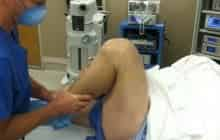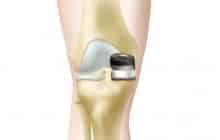Arthritic knee joints may need to be repaired either partially or totally – known as partial knee replacement and total knee replacement. If the bone disease is restricted to the inner side of the knee (the ‘medial’ side), the surgeon will simply reshape those damaged surfaces. The repaired surfaces on that one side of the knee are then partially covered with a combination of metal and plastic bearings. For this reason, a partial (also called “UNI”) knee replacement is considered less invasive than total knee replacement, in which all compartments of the knee joint are replaced.

iUni® Unicompartmental Knee Implant (image credit: ConforMIS)
The primary limitation with the UNI procedure is that the surgery only works for bone that has not been too damaged by the arthritis. It also requires that the other (‘lateral’) side of the knee joint have healthy cartilage. The average age of UNI knee patients will therefore be a lot younger than those going for total knee replacements. This means that the UNI resurfacing option may only be a good choice for a small percentage of knee patients.
Generally speaking, UNI knee replacements are not performed on patients with arthritic damage on both sides of the knee. In more arthritic knees, there will be considerable erosion and deformity on both sides of the knee joint (as in ‘medial’ and ‘lateral’ sides). This will require more repair of the upper joint bone and the lower joint bone and sometimes also behind the knee cap. The UNI knee cannot accommodate such destructive changes in bone structure. Therefore in this case a surgeon will often opt to perform a total knee replacement.
Note that the most common method of fixing both implants to the bone is with bone cement. There are also options to provide for bony attachment and ingrowth onto the implants (bone ingrowth fixation). The final step is to insert a plastic cover onto the metal tray to act as the bearing knee for the knee joint.
There are other options to consider. The majority of knee patients do not get their patella replaced, although this may become an option further down the road. There are also indications for knee operations that make use of bicompartmental partial knee replacement implants, smaller incisions (MIS: ‘minimally invasive surgery’) and use different kinds of instrumentation such as computer-assisted navigation (NAV).
Your doctor should explain to you which type of knee replacement surgery is best for you and why.
Filed Under: Knee ReplacementKnee Replacement, Resurfacing, Revision





